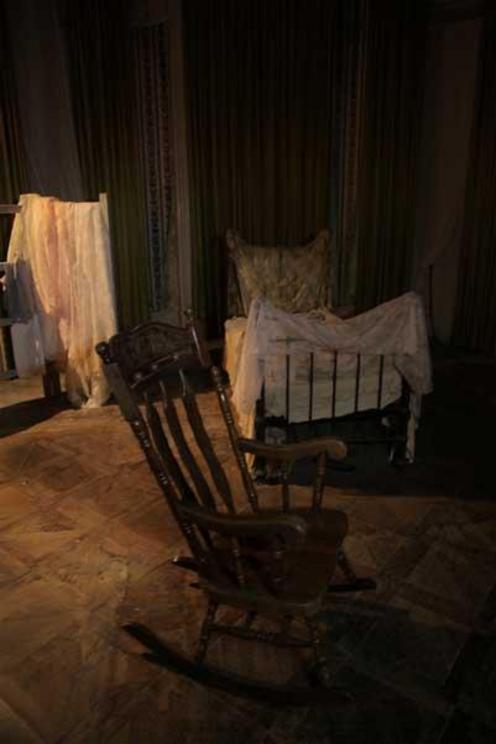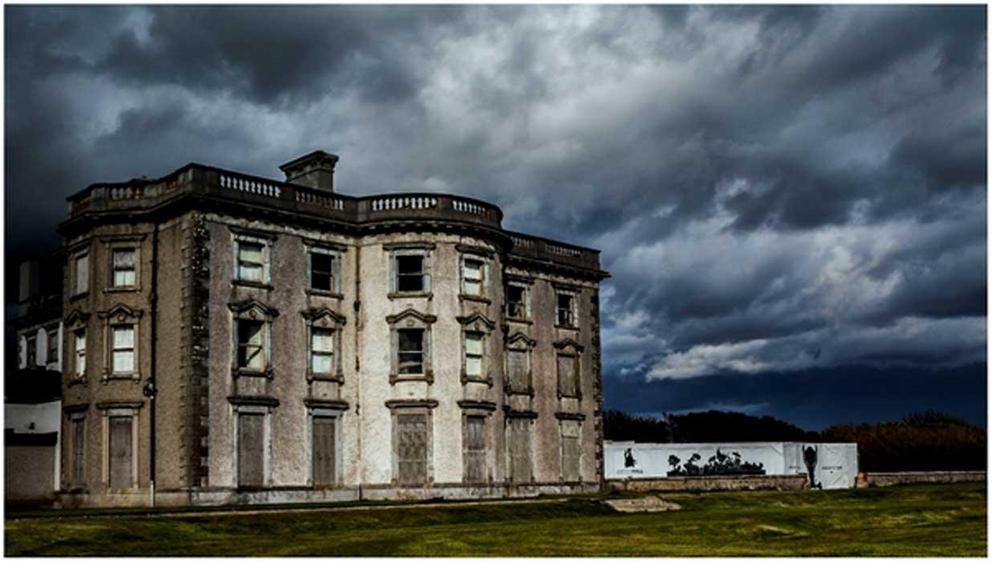Loftus Hall: most haunted house in Ireland has not revealed all its dark secrets
Driving along the isolated road that runs down the scenic Hook Peninsula in Ireland’s Ancient East, it is easy to spot the mansion that has earned itself the reputation as the most haunted house in Ireland. If ever a building fit the stereotype of a home haunted by its bloody and tragic past, this was it. Set against the backdrop of a rugged and windswept coastal setting, Loftus Hall looms over the surrounding landscape. Its historic walls have seen invasion, capture, plague, famine and numerous personal tragedies, many of which live on as ghostly legends still told today.
The recorded history of Loftus Hall and the land upon which it sits stretches back some 800 years, but locals say the significance of the site goes back thousands of years and was once sacred to the druids, the high-ranking professional and religious class in ancient Celtic cultures.

Loftus Hall looms over the surrounding landscape of the Hook Peninsula. Photo courtesy of Loftus Hall .
A Colorful Past
The story of Loftus Hall begins around 1170 AD, when Raymond (Redmond) Fitzgerald, nicknamed Le Gros (‘The Fat’), landed at Baginbun Head in the Hook Peninsula in what is now county Wexford in Ireland. It is a famous site in Irish history, known as the place “where Ireland was lost and won”. Raymond was among the first of a small band of Norman knights who played an active role in helping enforce Normal rule over Ireland. He acquired land in the area, upon which he built a castle known as Houseland Castle. Over the years, it fell into disrepair and in 1350, descendants of Raymond Le Gros built a new castle called The Hall or ‘Redmond Hall’.
The Hall remained with the Redmond family until the mid-1600s when the Irish Confederate Wars saw the castle repeatedly attacked and eventually seized as part of the Cromwellian confiscations. In one remarkable display of defence on 20 July 1642, Alexander Redmond, who was 68 at the time, managed to protect The Hall from around 90 English invaders, with just the help of his two sons, some tenants, two soldiers, and a tailor. They staved off several more attacks after which Alexander Redmond received favourable terms from Cromwell. Upon his death around 1651, Redmond’s family were evicted from The Hall and their home put up for auction. In 1666, Henry Loftus, originally from Yorkshire, England, acquired the confiscated lands and the mansion was renamed Loftus Hall.

Loftus Hall has seen a long and colorful history. Photo courtesy of Loftus Hall
Loftus Hall Rebuilt
Over the decades and centuries that followed, the Loftus family rose in the peerage, producing barons, viscounts, earls, and marquesses, and as they climbed the ladder of aristocracy, the illustrious family hoped they could entice Queen Victoria to visit. With that goal in mind, John Henry Loftus, the fourth Marquess of Ely, embarked on an enormous renovation of The Hall between 1870 and 1879 to make it grander than ever before. Although it is widely reported that Loftus Hall was completely demolished and rebuilt, there is evidence that much of the former Hall was utilized and worked into the mansion that can be seen today.
No expense was spared in the renovation of Loftus Hall. Erected as a three-story mansion, with a balustraded parapet, the Hall boasts an ornate mosaic floor and a spectacular grand staircase, hand carved by Italian craftsmen. The house certainly was fit for a queen, but Queen Victoria never arrived, causing deep disappointment to the Loftus family.

The impressive Loftus Hall Estate. Photo courtesy of Loftus Hall .
Insanity, Death and Tragedy Plagued the Historic Hall
While its rich and colorful past is enough to bring history-buffs flocking, it is the legends, the unexplained mysteries, and the tales of ghostly apparitions that have made Loftus Hall one of the most visited mansion’s in the whole of Ireland. The legends stem from the real life and death of Anne Tottenham.
In the mid-1600s, Charles Tottenham married the Honourable Anne Loftus, daughter of the first Viscount Loftus, and they had six children, four boys and two girls – Elizabeth and Anne. But his wife became ill and died while the girls were still young. Two years later, Tottenham married his cousin Jane Cliffe, and they lived together, along with Anne, in Loftus Hall.
One night, amid a powerful storm, a ship arrived at the Hook Peninsula and a young man made his way to Loftus Hall asking if he could take shelter there. It was not uncommon for strangers to come knocking, as the rough waters around the south Wexford coast often resulted in ships being grounded on the shore or shattered by rocks. The man was invited in and ended up residing at the house for several weeks.
During this time, Anne, now a young woman, fell in love with the stranger and spent countless hours socializing with him in the Tapestry Room. According to local legends, one evening, Anne was playing cards with the stranger, as well as other guests, when she leaned down under the table to collect a card she had dropped, and noticed that the stranger had cloven hoofs. She screamed loudly, causing the stranger to expose himself as the devil. He transformed into a ball of fire and shot up through the roof, leaving Anne in a state of trauma from which she never recovered.
Anne’s mental state deteriorated rapidly and her family, embarrassed by her behavior, confined her to a room in the house, where she remained until her death in around 1775. It is said that from this time onwards, Loftus Hall became plagued by severe poltergeist activity, the troubled Anne never able to rest in peace.
Several Protestant clergymen were summoned by the family to put a stop to it, but none could rid the house of its evil forces. In their desperation, the family, themselves Protestant, called upon a Catholic priest who was a tenant on their estate, Father Thomas Broaders, who was successful in cleansing the house of negative forces. It is popularly reported that his gravestone contains the inscription "Here lies the body of Thomas Broaders, who did good and prayed for all, and who banished the devil from Loftus Hall", though there is no evidence that this inscription ever existed.

The Tapestry Room of Loftus House. Is this really the card table where a stranger supposedly transformed into the devil and shot through the ceiling? Photo courtesy of Loftus Hall .

The room in Loftus Hall where Anne Tottenham is said to have been locked away . Photo courtesy of Loftus Hall .
Unravelling the Legend
It is fair to say that many of the details of this account are likely to be little more than fictional folk tales. Nevertheless, reports going back over a century say that Anne was indeed confined to a room in Loftus Hall until her death. So what really happened to her?
It is most likely that the account of the cloven hoof and the devil shooting through the roof was made up by the Loftus family to deter beggars and other strangers from paying a visit to the Hall. After all, they were desperately hoping to entice Queen Victoria for a visit, so the last thing they needed was ‘undesirables’ getting in the way.
This then raises the question as to whether Anne really was confined due to mental illness, or whether there was another reason for this tragic ending to her life. According to one alternative account, the stranger had fallen in love with Anne and had asked Charles Tottenham for her hand in marriage but was refused permission. He was turned away from the house, leaving Anne heartbroken.
But there is another twist in this story. During the restoration of Loftus Hall, the skeletal remains of a tiny infant were found between the walls in what is believed to have been the room Anne had been locked in. Did Anne fall pregnant with the stranger, casting shame upon her family? This could have provided a motive for her father to lock her away, never to be seen again.
One local account suggests that Anne died during childbirth after her father refused to let anyone know of her pregnancy, including the local doctor, and she suffered complications leading to her death.
Today, Anne Tottenham’s grave is located in a local graveyard in Wexford. But something is very peculiar about it. Unlike the surrounding graves, it is completely cemented over. The people that buried her clearly wanted to ensure no one could ever access her body. What dark secrets did Anne take with her to the grave?
Is Loftus Hall Haunted?
Metaphorically, Loftus Hall is indeed haunted by its dark and troubled history. One can almost feel the sadness and traumas that have taken place within its walls. But does the ghost of Anne still roam the cold and empty rooms of the mansion as it stands today? Many are convinced the answer is yes. Indeed, American Ghost Hunters carried out detailed investigations of the house and claimed to have detected numerous anomalies.
But it was in 2014 that Loftus Hall cemented its reputation as the most haunted house in Ireland when a visitor taking a tour believed that he captured a haunting image on his camera. It subsequently went viral, attracting the attention of people all around the world. Twenty-one-year-old Thomas Beavis said he was browsing through the photos on his camera when he noticed the ghostly figures of a young woman, and an older woman in a window.

A trick of the light or the ghost of Anne Tottenham alongside her mother? Credit: Thomas Beavis
Loftus Hall Today
In the early 20 th century, the Loftus family went bankrupt and, following the death of the last member of the Loftus family, it was taken over by the Benedictines, who occupied it until 1935. In 1937, the Sisters of Providence converted it into a convent and school for young girls wanting to join the order. Locals say that people were terrified to attend Mass in its chapel given the well-circulated legends of the devil himself visiting the Hall.
In 1983, Loftus Hall was purchased by Michael Deveraux who opened it as ‘Loftus Hall Hotel’. Michael died in the Hall and his wife struggled for several years trying to run the hotel on her own, until one night she took off without any explanation, leaving everything behind.
Loftus Hall then entered another dark period - the property was left vacant but was occupied illicitly for nearly a decade by people conducting satanic rituals and meetings.
In 2011, it was purchased by its current owners, the Quigley family, who have embarked on an ambitious project of restoration. Today, Loftus Hall is open to the public, who can join a 45-minute guided tour that showcases the history of the Hall and its many legends.
Leaving the Hall after one of these tours, one is left with more questions than answers. Fact and fiction have become so closely entwined in the history of Loftus Hall that it is impossible to determine where history ends and the legend begins.
‘Loftus: The Hall of Dreams’ written by Helena B. Scott with photographs by Steve Meyler . Read more at: www.thehallofdreams.com
 Loftus Hall
Loftus Hall
The eerie mansion that is today known as Loftus Hall. Photo courtesy of Loftus Hall .
For the rest of this article please go to source link below.
For full references please use source link below.
Video can be accessed at source link below.
